Diastasis recti is a separation of the abdominal muscles‚ often occurring during pregnancy. Physiotherapy plays a crucial role in recovery through targeted exercises and muscle engagement.
What is Diastasis Recti?
Diastasis recti‚ also known as diastasis rectus abdominis (DRA)‚ is a separation of the abdominal muscles‚ specifically the rectus abdominis muscle. This occurs when the connective tissue (linea alba) that holds the abdominal muscles together weakens or stretches‚ causing the muscles to split apart. It is most commonly associated with pregnancy but can also result from heavy lifting‚ abdominal surgery‚ or chronic strain on the abdominal wall. The separation can lead to a visible bulge or “pooch” in the abdominal area and may cause discomfort‚ poor posture‚ or instability in the core. While it is a natural occurrence for many‚ especially postpartum‚ untreated diastasis recti can lead to further complications‚ such as back pain or hernias‚ emphasizing the importance of targeted physiotherapy exercises for recovery.
Causes and Risk Factors
Diastasis recti is primarily caused by increased intra-abdominal pressure‚ which can weaken the connective tissue (linea alba) holding the abdominal muscles together. Pregnancy is a leading cause due to hormonal changes and the stretching of abdominal muscles to accommodate a growing fetus. Other risk factors include multiple pregnancies‚ rapid weight gain‚ and a weak core. Postpartum women‚ particularly those with cesarean sections‚ are at higher risk. Additionally‚ repetitive heavy lifting‚ chronic coughing‚ or abdominal exercises that strain the core‚ such as crunches‚ can contribute to the condition. Aging and genetic predisposition may also play a role in weakening abdominal tissue. Understanding these causes helps in developing effective physiotherapy strategies to address and prevent further separation.
Importance of Physiotherapy in Diastasis Recti Recovery
Physiotherapy is essential for diastasis recti recovery as it focuses on strengthening the deep abdominal and pelvic floor muscles‚ which are critical for core stability. It helps improve posture‚ reduce discomfort‚ and promote healing without surgery. By targeting the transversus abdominis muscle‚ physiotherapy restores the abdominal wall’s integrity and functionality. Additionally‚ it addresses muscle imbalances and improves overall core strength‚ which is vital for daily activities and preventing further separation. Physiotherapy also provides personalized exercises tailored to individual needs‚ ensuring a safe and effective recovery process. It is particularly beneficial for postpartum women‚ offering a non-invasive approach to regain abdominal strength and confidence. Regular physiotherapy sessions can significantly enhance the quality of life for those affected by diastasis recti.

Understanding Diastasis Recti Physiotherapy
Diastasis recti physiotherapy focuses on strengthening deep abdominal muscles‚ improving posture‚ and enhancing core stability through targeted exercises and breathing techniques. It is a non-invasive‚ effective approach to recovery.
Goals of Physiotherapy Exercises
The primary goals of physiotherapy exercises for diastasis recti are to strengthen the deep core muscles‚ improve posture‚ and enhance overall abdominal stability. These exercises aim to reduce the separation of the abdominal muscles‚ restore proper muscle function‚ and improve intra-abdominal pressure regulation. By targeting the transversus abdominis and pelvic floor muscles‚ physiotherapy helps regain a strong‚ supportive core. Additionally‚ these exercises focus on reducing discomfort‚ improving mobility‚ and preventing further muscle separation. The ultimate objective is to empower individuals to return to daily activities and exercises safely‚ with a reduced risk of injury or strain. Consistency and proper technique are emphasized to achieve long-term benefits and overall core strength.
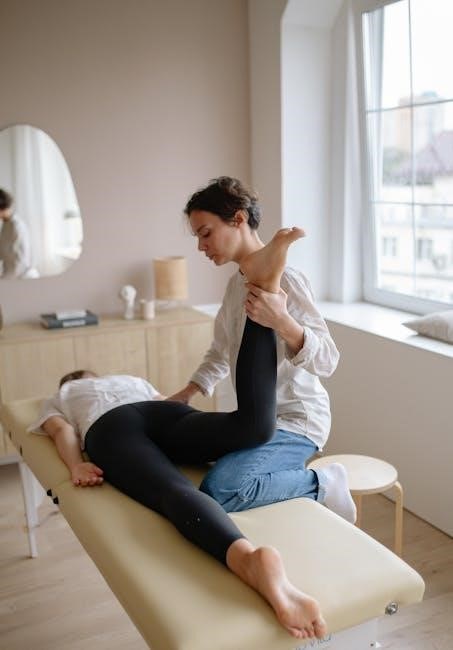
Key Muscles Targeted in Physiotherapy
Physiotherapy for diastasis recti primarily focuses on strengthening the transversus abdominis‚ the deepest abdominal muscle‚ which acts as an inner girdle. This muscle is crucial for stabilizing the spine and pelvis. Additionally‚ exercises target the pelvic floor muscles‚ which work in conjunction with the transversus abdominis to provide core stability and support. The rectus abdominis‚ though separated‚ also benefits from these exercises to improve overall abdominal wall function. Secondary focus is placed on the obliques‚ which aid in rotational movements and further stabilize the core. Strengthening these muscles collectively helps restore proper posture‚ reduce separation‚ and enhance overall core strength‚ which is essential for daily activities and preventing further injury.
The Role of the Transversus Abdominis Muscle
The transversus abdominis (TVA) muscle plays a pivotal role in diastasis recti recovery. As the deepest abdominal muscle‚ it wraps around the spine and pelvis‚ functioning like an internal corset. Engaging the TVA helps stabilize the abdominal contents and reduce the separation between the rectus abdominis muscles. Physiotherapy exercises‚ such as abdominal drawing-in and deep breathing‚ specifically target the TVA to improve its strength and endurance. Strengthening this muscle not only supports the abdominal wall but also enhances posture‚ reduces lower back pain‚ and improves overall core stability. Proper activation of the TVA is often the foundation of effective diastasis recti physiotherapy‚ as it provides the necessary support for other muscles to function optimally during recovery.
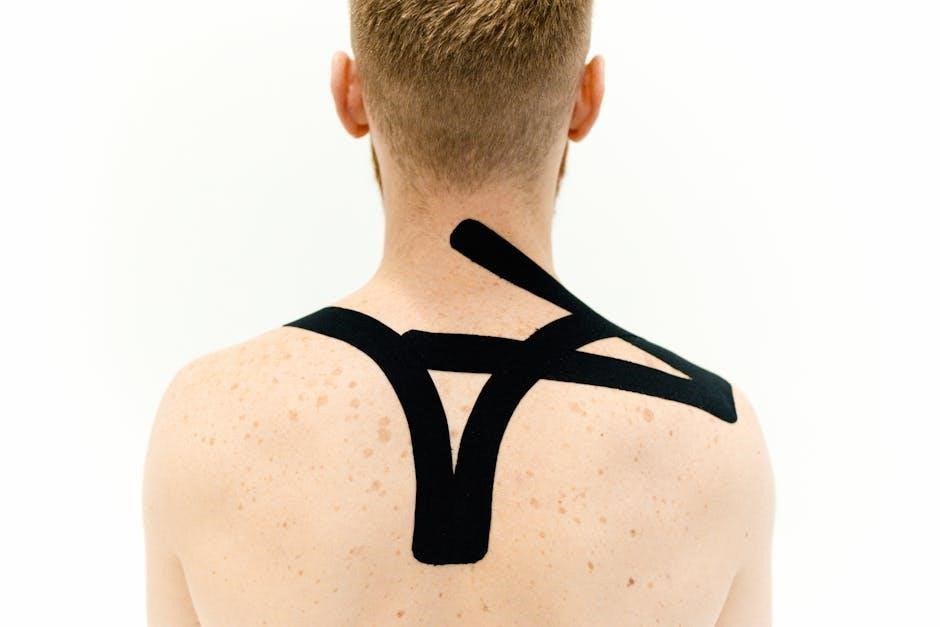
Core Physiotherapy Exercises for Diastasis Recti
Core exercises focus on strengthening abdominal and pelvic floor muscles to improve posture‚ stability‚ and reduce separation. They are essential for postnatal recovery and long-term core health.
Abdominal Drawing-In Exercise
The abdominal drawing-in exercise is a foundational movement for diastasis recti recovery. Lie on your back with knees bent and feet flat‚ hands resting on your abdomen. Engage your transversus abdominis by gently pulling your belly button toward your spine‚ without holding your breath. Hold for 5-10 seconds‚ release slowly‚ and repeat 10-15 times. This exercise strengthens the deep abdominal muscles‚ improving core stability and reducing muscle separation. Proper form is key to avoid strain. Focus on a subtle activation‚ maintaining a neutral spine. Over time‚ this exercise enhances muscle awareness and promotes healing. Regular practice is essential for long-term core strength and postural improvement. Avoid forceful exhaling or using external pressure to ensure safe and effective execution.
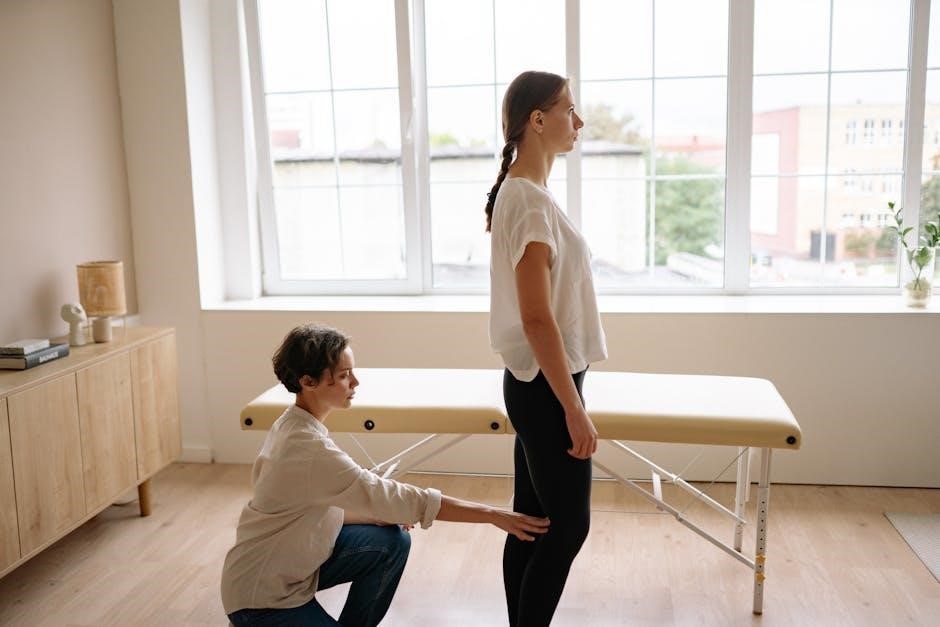
Pelvic Floor Muscle Exercises
Pelvic floor muscle exercises are essential for diastasis recti recovery‚ as they strengthen the muscles that support the abdomen and pelvis. To perform these exercises‚ sit or lie down comfortably‚ engage your pelvic floor by squeezing as if stopping the flow of urine‚ and hold for 5-10 seconds. Release slowly and repeat 10-15 times. These exercises improve core stability‚ reduce muscle separation‚ and enhance overall pelvic floor function. Focus on slow‚ controlled movements to maximize effectiveness. Over time‚ this helps restore the muscle connection between the pelvic floor and transversus abdominis‚ promoting better posture and reducing discomfort. Regular practice strengthens the foundation of your core‚ aiding in diastasis recti healing. Avoid using abdominal muscles to push down; instead‚ isolate the pelvic floor for best results. Consistency is key to achieving long-term benefits and supporting your core recovery journey.
Deep Breathing Exercises
Deep breathing exercises are a fundamental component of diastasis recti recovery‚ as they engage the diaphragm and promote activation of the transversus abdominis muscle. Lie on your back with knees bent and hands on your abdomen. Inhale deeply through your nose‚ allowing your belly to rise as your diaphragm descends. Exhale slowly through pursed lips‚ gently drawing your belly button toward your spine. This technique strengthens abdominal muscles‚ improves posture‚ and enhances core stability. Practice 5-10 deep breaths several times daily to foster muscle memory and support recovery. Consistency is key‚ as these exercises help restore muscle function without putting strain on the abdominal wall. Over time‚ deep breathing can improve overall core engagement and aid in healing diastasis recti effectively.
Heel Slides
Heel slides are a gentle and effective exercise for addressing diastasis recti by strengthening the transverse abdominis muscle without increasing intra-abdominal pressure. Lie on your back with knees bent and feet flat on the floor. Slowly slide one heel toward your body while keeping your foot flexed‚ allowing your knee to bend further. As you slide‚ engage your deep abdominal muscles by gently drawing your belly button toward your spine. Hold for a breath‚ then slowly return to the starting position. Perform 10-15 slides on each side‚ repeating for 2-3 sets daily. This exercise promotes core stability and supports the healing of abdominal muscle separation. It is particularly beneficial for postpartum recovery and can be modified to suit individual comfort levels. Consistency is key to achieving optimal results and improving overall core strength.
Bird Dog Exercise
The Bird Dog Exercise is a highly effective core stabilization exercise that targets the transverse abdominis muscle‚ crucial for addressing diastasis recti. Begin on your hands and knees in a tabletop position‚ ensuring your spine is neutral. Engage your deep abdominal muscles by drawing your belly button toward your spine. Slowly extend one arm forward and the opposite leg backward‚ keeping them aligned with your torso. Hold for a breath‚ then return to the starting position. Perform 10-15 repetitions on each side‚ completing 2-3 sets daily. This exercise improves posture‚ enhances core stability‚ and strengthens the pelvic floor muscles without increasing intra-abdominal pressure‚ making it ideal for diastasis recti recovery. Focus on maintaining a stable pelvis and controlled breathing throughout the movement.
Plank Variations
Plank variations are excellent for strengthening the core muscles without putting excessive strain on the abdominal wall‚ making them suitable for diastasis recti recovery. Start with modified planks‚ such as knee planks or half planks‚ to build stability. Engage your transverse abdominis by drawing your belly button toward your spine and maintain a neutral spine. For a standard plank‚ place your hands under your shoulders and toes on the ground‚ holding for 10-20 seconds while breathing naturally. Progress to side planks or stability ball planks for added challenge. Perform 3 sets of 3-5 repetitions. Plank variations improve posture‚ reduce muscle imbalances‚ and enhance overall core stability‚ which is essential for healing diastasis recti. Always prioritize proper form to avoid exacerbating the condition.
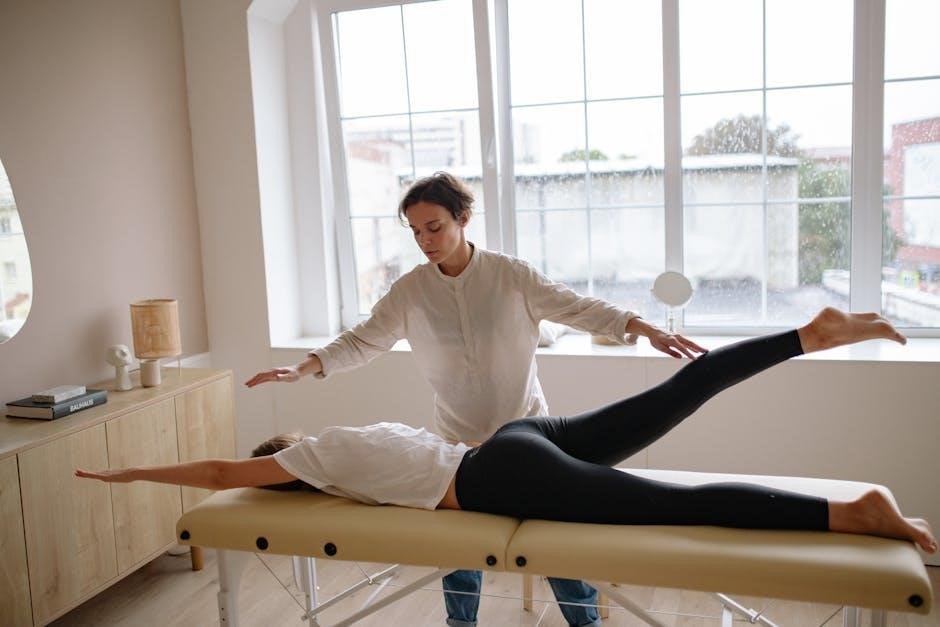
Additional Physiotherapy Techniques
Postural correction‚ progressive resistance exercises‚ and supportive props like splinting enhance recovery. These techniques strengthen core stability and reduce strain on the abdominal wall effectively.
Postural Correction and Awareness

Postural correction is essential in managing diastasis recti‚ as poor posture can exacerbate the separation. Physiotherapists guide patients to adopt neutral spine positions‚ ensuring proper alignment of the pelvis and shoulders. Awareness exercises help individuals identify and adjust their posture during daily activities‚ reducing strain on the abdominal wall. Techniques include pelvic tilts‚ shoulder relaxation‚ and mindful breathing. Strengthening the deep stabilizers‚ like the transversus abdominis‚ further supports postural improvements. By integrating these practices‚ patients can reduce discomfort and promote a more efficient healing process‚ ultimately enhancing core stability and overall physical function.
Progressive Resistance Exercises
Progressive resistance exercises are tailored to strengthen the core muscles gradually‚ enhancing stability without overstraining the abdominal wall. These exercises often involve gentle resistance‚ such as using bands or light weights‚ to engage the transversus abdominis and pelvic floor muscles. They are designed to improve muscle endurance and strength over time‚ promoting better support for the spine and pelvis. Physiotherapists typically introduce these exercises once foundational stability is achieved‚ ensuring proper form to avoid exacerbating the diastasis. By progressively increasing resistance‚ individuals can rebuild core resilience‚ reduce the appearance of muscle separation‚ and restore functional movement patterns. These exercises are a key component of advanced physiotherapy programs for diastasis recti recovery‚ offering a safe and effective way to strengthen the core.
Use of Supportive Props (e.g.‚ Splinting)
Supportive props‚ such as splinting‚ are often utilized in physiotherapy to aid individuals with diastasis recti. Splints or abdominal binders provide external compression‚ helping to stabilize the abdominal wall and reduce separation. These props can be particularly beneficial during early stages of recovery or when performing exercises that might strain the core. By offering additional support‚ splinting enables individuals to engage in exercises without discomfort or risk of further injury. Physiotherapists may recommend specific types of binders or braces tailored to the individual’s needs. While splinting is not a long-term solution‚ it serves as a valuable tool to enhance the effectiveness of exercises and promote proper healing during the recovery process.
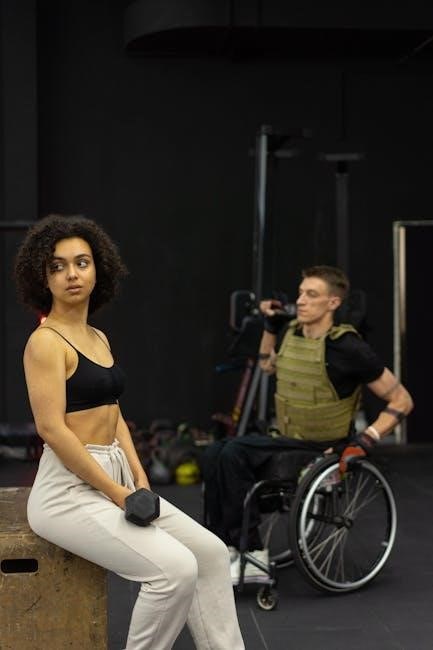
Exercises to Avoid During Diastasis Recti Recovery
Exercises like crunches‚ sit-ups‚ heavy lifting‚ and bending should be avoided as they can increase intra-abdominal pressure‚ worsening the separation of abdominal muscles.
Why Crunches and Sit-Ups Should Be Avoided
Crunches and sit-ups should be avoided during diastasis recti recovery as they can worsen the separation. These exercises increase intra-abdominal pressure‚ putting strain on the abdominal wall and potentially causing further damage to the linea alba. Activities that involve flexion or heavy lifting can disrupt the healing process and delay recovery. Instead‚ low-impact exercises that strengthen the transversus abdominis and pelvic floor muscles are recommended; Avoiding such movements ensures the abdominal muscles can heal properly without additional stress.
Heavy Lifting and Bending
Heavy lifting and bending can significantly hinder diastasis recti recovery by increasing intra-abdominal pressure. These activities strain the abdominal wall‚ potentially worsening the separation. Lifting heavy objects or bending at the waist can cause the abdominal muscles to bulge‚ putting additional stress on the already compromised connective tissue. If lifting is unavoidable‚ it’s crucial to engage the core muscles by drawing the belly button toward the spine and maintaining proper posture. This helps distribute the load more evenly and reduces the risk of further injury. Avoiding heavy lifting and bending is essential to allow the abdominal muscles to heal effectively and prevent long-term damage.
Activities That Increase Intra-Abdominal Pressure
Activities that increase intra-abdominal pressure can worsen diastasis recti by putting additional strain on the abdominal wall. These include coughing‚ sneezing‚ or laughing forcefully‚ as well as high-intensity exercises like jumping or running. Even everyday actions‚ such as pushing heavy objects or children‚ can exacerbate the condition. Such activities cause the abdominal contents to push outward‚ creating pressure that can further separate the abdominal muscles. Avoiding these activities is crucial during recovery to prevent delaying healing. Instead‚ focus on low-impact movements and core-strengthening exercises that stabilize the abdomen without increasing pressure. Consulting a physiotherapist can help identify safe alternatives and modifications to daily activities.

Creating a Safe and Effective Workout Plan
A safe workout plan for diastasis recti focuses on gentle‚ core-strengthening exercises‚ proper posture‚ and deep breathing techniques. Progress gradually‚ monitoring progress and adjusting as needed.
How to Start: A Beginner’s Guide
Starting a physiotherapy program for diastasis recti begins with gentle‚ low-intensity exercises. Begin by lying on your back with knees bent and engage your deep abdominal muscles by drawing your belly button toward your spine. Practice deep breathing exercises to activate your transversus abdominis muscle‚ which helps stabilize your core. Pelvic floor muscle exercises should also be incorporated to strengthen the muscles that support your abdomen and pelvis. Avoid any movements that cause your abdominal wall to bulge or create pressure. Consult a physiotherapist to assess your condition and create a personalized plan; Start slowly‚ focusing on proper posture and controlled movements. Use supportive props like pillows or splints if needed to help maintain proper alignment. Track your progress weekly and gradually increase the intensity of your exercises as your strength improves.
Progressing Your Exercise Routine
As your strength and core stability improve‚ gradually increase the intensity of your exercises. Introduce gentle resistance using bands or light weights‚ focusing on controlled movements. Extend the duration and frequency of your workouts‚ ensuring proper form is maintained. Incorporate dynamic exercises like modified bird dogs or side planks to challenge your core further. Progress to standing or kneeling positions for exercises like heel slides or pelvic tilts‚ which mimic daily activities. Strengthen postural muscles to enhance overall stability and reduce strain on your abdomen. Avoid high-impact movements or heavy lifting until fully recovered. Always listen to your body and seek professional guidance if discomfort arises. Progression should be slow and tailored to your individual recovery pace.

Monitoring Progress and Adjustments
Regularly tracking your progress is essential for effective recovery. Use a journal to record the frequency‚ duration‚ and intensity of your workouts. Note improvements in core strength‚ posture‚ and reductions in abdominal separation. Take progress photos and measurements to visually monitor changes. If certain exercises cause discomfort or bulging‚ discontinue them and consult your physiotherapist. Adjustments may include modifying exercise techniques‚ incorporating new exercises‚ or increasing resistance as strength improves. Stay consistent with your routine and celebrate small achievements to maintain motivation. Be patient‚ as progress may be gradual‚ and remember that each individual’s recovery timeline is unique.
Recovery from diastasis recti is a journey requiring patience and consistency. Physiotherapy offers effective tools for healing and strengthening. Always consult a physiotherapist for personalized guidance and support.
The Importance of Patience and Consistency
Patience and consistency are vital for effective diastasis recti recovery. Healing requires time as muscles strengthen and tissues repair. Regular practice of exercises like abdominal drawing-in and deep breathing helps improve core stability. Inconsistent efforts may slow progress‚ while dedicated routines yield better results. Setting realistic expectations and celebrating small milestones can maintain motivation. Progress often becomes noticeable within weeks‚ but full recovery may take months. Staying committed ensures long-term benefits and reduces the risk of further separation. Remember‚ recovery is a gradual process that demands dedication and perseverance. Consulting a physiotherapist can provide personalized guidance and support‚ enhancing the effectiveness of your journey.
When to Seek Professional Guidance
Seeking professional guidance is essential if you experience persistent abdominal separation‚ pain‚ or difficulty engaging core muscles. A physiotherapist can provide personalized exercises tailored to your needs‚ ensuring safe and effective recovery. If you notice limited progress despite consistent effort‚ or if exercises cause discomfort‚ professional advice is crucial. Additionally‚ if you’re unsure about proper techniques or worsening symptoms‚ consulting a specialist can prevent further issues. They can assess your condition‚ offer customized plans‚ and address any underlying imbalances. Professional guidance empowers you to recover confidently‚ avoiding potential setbacks. Don’t hesitate to reach out for expert support to enhance your journey toward healing and strength.
